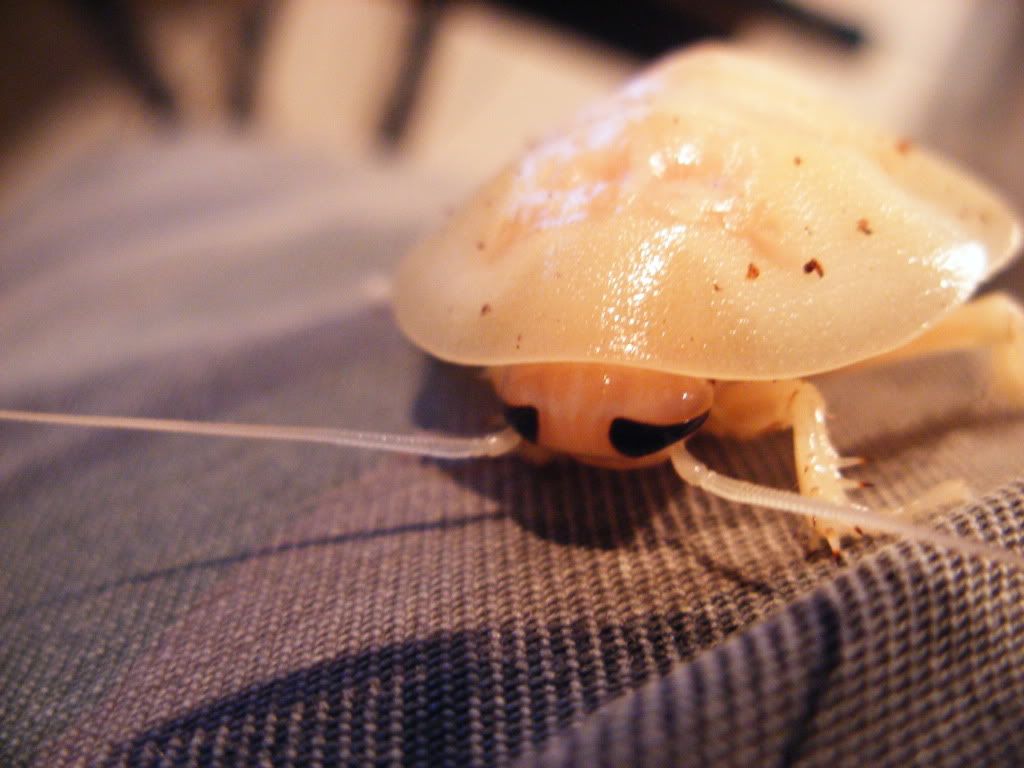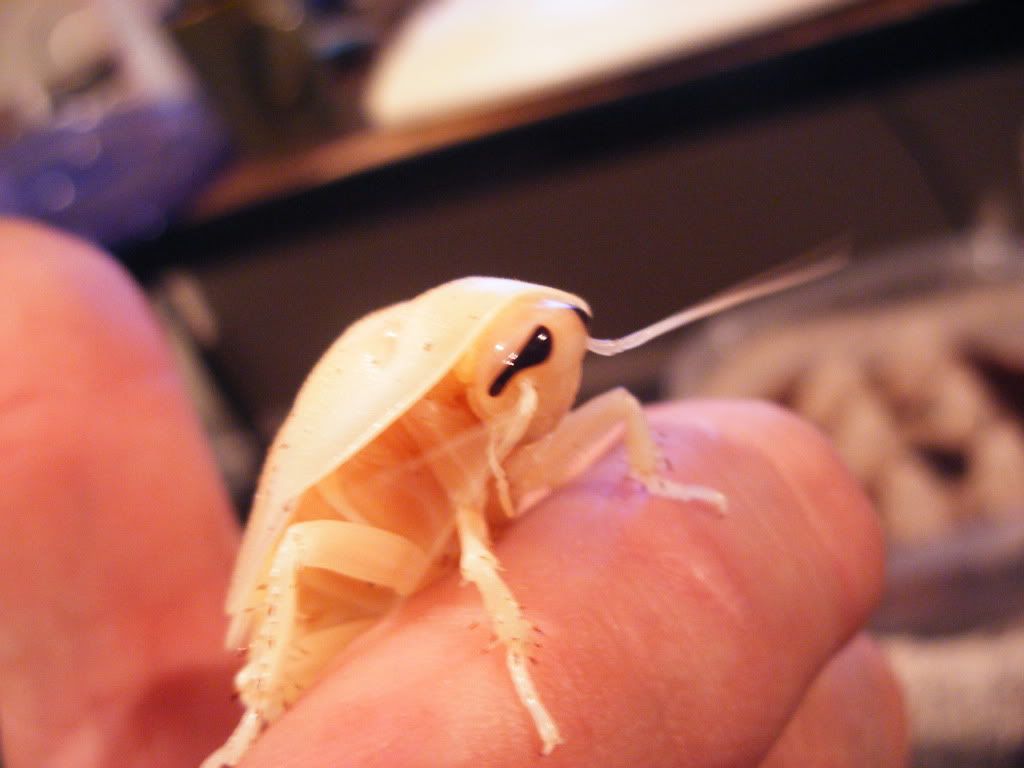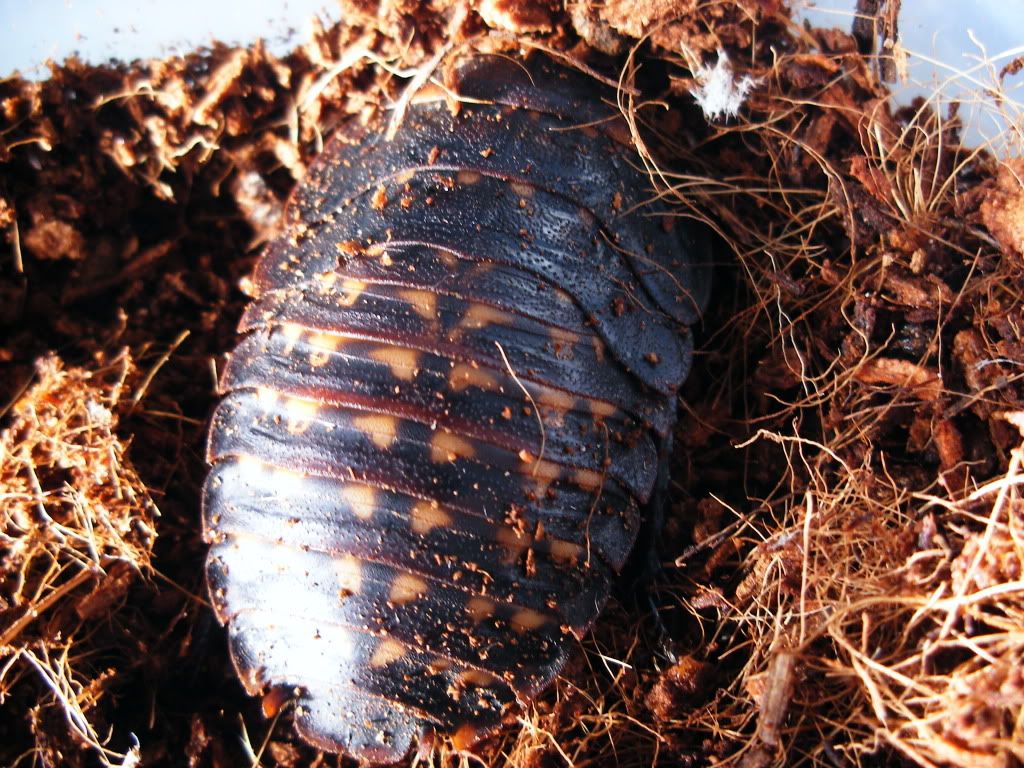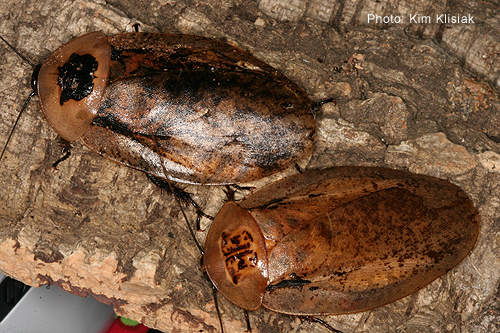Guest viewing is limited
- You have a limited number of page views remaining
- 2 guest views remaining
- Register now to remove this limitation
- Already a member? Click here to login
You are using an out of date browser. It may not display this or other websites correctly.
You should upgrade or use an alternative browser.
You should upgrade or use an alternative browser.
Cockroach of the "Week" 11/2/09- Archimandrita tesselata
- Thread starter Zephyr
- Start date
Matt K
Eurycotis
This "week's" RotW (chosen by Kimix) is the giant peppered cockroach- Archimandrita tesselata.
...since I unintentionally hijacked the previous roach over this one, I am setting things back on course!
This is an excellent species for anyones collection. They have several unusual and unique qualities to them that in my opinion make them a necessary part of anybody's collection.
Here are a couple of photos I took of a Peppered roach in the wild (Costa Rica) and one of mine here compared to a Blaberus giganteus.
(*yes, I have large hands, but am tall/bigger than most people)


...since I unintentionally hijacked the previous roach over this one, I am setting things back on course!
This is an excellent species for anyones collection. They have several unusual and unique qualities to them that in my opinion make them a necessary part of anybody's collection.
Here are a couple of photos I took of a Peppered roach in the wild (Costa Rica) and one of mine here compared to a Blaberus giganteus.
(*yes, I have large hands, but am tall/bigger than most people)


OBJ
Fourth Instar
The picture has disappeared from the first post - is that correct?
Please find a couple of recent pictures from here.
The coloring and textures of these roaches must be amongst the favourites. Very nice indeed.
The photos can not be uploaded - the upload capacity is over its limit - unfortunately you have to use the link...
Adult tesselata, side view
Adult, alert
tesselata nymph, the coloring is very nice
tesselata nymph checking up on the photographer...
By using the advice of Matt.K it has been possible to minimize the phorid flies. So the substrate is now dried beech leaves. No water is sprayed - only fruit and vegetables are adding moisture to the colony plus occationally some water gel with vitamins.
BR/
Ole
Please find a couple of recent pictures from here.
The coloring and textures of these roaches must be amongst the favourites. Very nice indeed.
The photos can not be uploaded - the upload capacity is over its limit - unfortunately you have to use the link...
Adult tesselata, side view
Adult, alert
tesselata nymph, the coloring is very nice
tesselata nymph checking up on the photographer...
By using the advice of Matt.K it has been possible to minimize the phorid flies. So the substrate is now dried beech leaves. No water is sprayed - only fruit and vegetables are adding moisture to the colony plus occationally some water gel with vitamins.
BR/
Ole
Last edited by a moderator:
buddylee79
Third Instar
Just got the species....but here are some pics...






Roachman26
Seventh Instar
Hello Matt K. I've never kept this species, but I intend to soon. What are the unique and unusual qualities you refer to? I'm familiar with husbandry for hissers, dubia and a few of the more common Blaberus sp. Do these need anything different?
If you've bred B. giganteus you'll have no problem with these. All they need is a good platform to drop their wings from, and oak leaves coupled with a good substrate.Hello Matt K. I've never kept this species, but I intend to soon. What are the unique and unusual qualities you refer to? I'm familiar with husbandry for hissers, dubia and a few of the more common Blaberus sp. Do these need anything different?
As for unique qualities... This is my favorite roach because they're so dang handleable and personable.
-Kyle
Roachman26
Seventh Instar
Thanks Kyle. Please pardon my ignorance. I've never used substrate for any of my roaches. I'd like to use one of my 18 gallon dark plastic tubs with fine coconut husk for bedding and verticle eggrates for climbing. Will this work? Also, I've got scrub, golden, and California Coastal Oak trees on my ranch. Are these suitable? I've also got Mullberry, Black Locust Tree, SilverDollar Aspen, California Pepper, Brazilian Pepper and one we call "piss elm". I can get leaves, dead or alive, and "rotting" wood from any of these trees. Do any of these work? And do I need to sterilize the rotting wood like the oak leaves. B. giganteous is one of the others I'm looking to get. Will this set up work for them too?If you've bred B. giganteus you'll have no problem with these. All they need is a good platform to drop their wings from, and oak leaves coupled with a good substrate. As for unique qualities... This is my favorite roach because they're so dang handleable and personable.
-Kyle
Sounds good for both of them. Just make sure they have that molting space. *too many egg crates can hinder their wings dropping properly.*Thanks Kyle. Please pardon my ignorance. I've never used substrate for any of my roaches. I'd like to use one of my 18 gallon dark plastic tubs with fine coconut husk for bedding and verticle eggrates for climbing. Will this work? Also, I've got scrub, golden, and California Coastal Oak trees on my ranch. Are these suitable? I've also got Mullberry, Black Locust Tree, SilverDollar Aspen, California Pepper, Brazilian Pepper and one we call "piss elm". I can get leaves, dead or alive, and "rotting" wood from any of these trees. Do any of these work? And do I need to sterilize the rotting wood like the oak leaves. B. giganteous is one of the others I'm looking to get. Will this set up work for them too?
I'd stick with just the oaks, the locust, and the mulberry.
Last edited by a moderator:
It was a choice between Zepher and Buddylee79 for my vote. Zepher seemed to have grasped the roaches's colors brighter and richer than the photos directly below his.
However, Buddylee's are much brighter and beautiful. Plus their upclose and you can see their legs and antennae real good. Especially the bottom one with the roach on his finger looking up at him. Though I know roaches don't really have the capacity to love us back, it does look like an owner/pet bond. SWEET!
However, Buddylee's are much brighter and beautiful. Plus their upclose and you can see their legs and antennae real good. Especially the bottom one with the roach on his finger looking up at him. Though I know roaches don't really have the capacity to love us back, it does look like an owner/pet bond. SWEET!
island reptiles
Third Instar
we have a small colony of these guys (2.3 adults mixed small nymphs unknown amount) I 100% agree these guys are great very easy to handle and over all impressive size
Keith
Megaloblatta
Is it true B Giganteus are slightly longer, but these are the heavier of the 2?we have a small colony of these guys (2.3 adults mixed small nymphs unknown amount) I 100% agree these guys are great very easy to handle and over all impressive size



